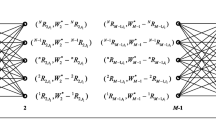Abstract
In Short-term Cascade Reservoirs Optimal Operation (SCROO), the flow from upstream reservoir to downstream reservoir which propagates in the natural channel can be generalized as not only transposition but also attenuation. In order to get the relative accurate inflow series of downstream reservoir, the paper tries to adopt the Muskingum model to simulate the inflow of the downstream reservoir instead of the easier processing in most papers of SCROO: ignoring the flow attenuation in natural channel. Considering the flow attenuation between the cascade reservoirs, the SCROO problem do not satisfy the “Principe of Optimality” anymore, so the Dynamic Programming(DP) is no longer applicable. The paper proposes a new improved DP named Multi-Stage Dynamic Programming (MSDP) based on DP. In MSDP, multi-stage’s outflow of upstream reservoir is taken into account at the same time and then inflow of downstream reservoir can be calculated by the Muskingum model, which can include much more flow information than the easier processing with DP, and the inflow of downstream reservoir will be closer to the actual one. The paper takes the cascade hydro-power stations consisting of Jindong and Guandi in Yalong river basin as an example to solve the SCROO problem with MSDP. By comparing the operation result of MSDP and DP with the easier processing, the operation strategy of MSDP can gain further benefits than DP’s in actual operation.









Similar content being viewed by others
References
Ahmad A, Razali SFM, Mohamed ZS (2016) The application of artificial bee Colony and gravitational search algorithm in reservoir optimization. Water Resour Manag 30(7):2497–2516
Bai Y, Chen Z, Xie J (2015) Daily reservoir inflow forecasting using multiscale deep feature learning with hybrid models. J Hydrol 532:193–206
Bellman RE (1957) Dynamic programming. Princeton University Press, Princeton Republished 2003: Dover, ISBN 0-486-42809-5
Chang J, Meng X, Wang ZZ (2014) Optimized cascade reservoir operation considering ice flood control and power generation. J Hydrol 519:1042–1051
Deka PC, Chandramouli V (2009) Fuzzy neural network modeling of reservoir operation. J Water Resour Plan Manag 135(1):5–12
Gavilan G, Houck MH (1985) Optimal Muskingum River Routing. Computer Applications in Water Resour. ASCE 1294–1302
Ge XL, Zhang LZ, Shu J (2014) Short-term hydropower optimal scheduling considering the optimization of water time delay. Electr Power Syst Res 110(5):188–197
Gill MA (1978) Flood routing by the Muskingum method. J Hydrol 36(3–4):353–363
Hsu NS, Wei CC (2007) A multipurpose reservoir real-time operation model for flood control during typhoon invasion. J Hydrol 336(3–4):282–293
Ji C, Jiang Z, Sun P (2014) Research and application of multidimensional dynamic programming in Cascade reservoirs based on multilayer nested structure. J Water Resour Plan Manag 141(7)
Jiang Z (2012) Application study of river routing on short-term optimal dispatching. Doctoral dissertation, Huazhong University of Science and Technology
Kim JH, Geem ZW, Kim ES (2001) Parameter estimation of the nonlinear Muskingum model using harmony search. J Am Water Resour Assoc 37(5):1131–1138
Kumar DN, Reddy MJ (2007) Multipurpose reservoir operation using particle swarm optimization. J Water Resour Plan Manag 133(3):192–201
Long LN, Madsen H, Dan R (2007) Simulation and optimisation modelling approach for operation of the Hoa Binh reservoir, Vietnam. J Hydrol 336(3–4):269–281
Mo L, Lu P, Wang C (2013) Short-term hydro generation scheduling of three gorges–Gezhouba cascaded hydropower plants using hybrid MACS-ADE approach. Energy Convers Manag 76(12):260–273
Momtahen S, Dariane AB (2007) Direct search approaches using genetic algorithms for optimization of water reservoir operating policies. J Water Resour Plan Manag 133(3):202–209
Perumal M, Price RK (2013) A fully mass conservative variable parameter McCarthy–Muskingum method: theory and verification. J Hydrol 502(21):89–102
Tong B, Zhai Q, Guan X (2013) An MILP based formulation for short-term hydro generation scheduling with analysis of the linearization effects on solution feasibility. IEEE Trans Power Syst 28(4):3588–3599
Wang J (2009) Short-term generation scheduling model of Fujian hydro system. Energy Convers Manag 50(4):1085–1094
Wang GT, Singh VP (1992) Muskingum method with variable parameters for flood routing in channels. J Hydrol 134(1–4):57–76
Zhang Z, Zhang S, Wang Y (2013) Use of parallel deterministic dynamic programming and hierarchical adaptive genetic algorithm for reservoir operation optimization. Comput Ind Eng 65(2):310–321
Zhang J, Lin S, Qiu W (2015) A modified chaotic differential evolution algorithm for short-term optimal hydrothermal scheduling. Int J Elec Power 65:159–168
Zhao T, Zhao J, Yang D (2014) Improved dynamic programming for hydropower reservoir operation. J Water Resour Plan Manag 140(3):365–374
Acknowledgements
This research is supported by the National Key Research and Development Program of China (2016YFC0402208, 2016YFC0402308, 2016YFC0402309), the Natural Science Foundation of China (51279062, 51679088, 51641901) and the Central University Basic Scientific Research Business Special Fund Project (2015XS50). Specially, the authors are grateful for the language help from Zhen Zumin and all the reviewers of this paper.
Author information
Authors and Affiliations
Corresponding author
Rights and permissions
About this article
Cite this article
Ji, C., Li, C., Wang, B. et al. Multi-Stage Dynamic Programming Method for Short-Term Cascade Reservoirs Optimal Operation with Flow Attenuation. Water Resour Manage 31, 4571–4586 (2017). https://doi.org/10.1007/s11269-017-1766-7
Received:
Accepted:
Published:
Issue Date:
DOI: https://doi.org/10.1007/s11269-017-1766-7




